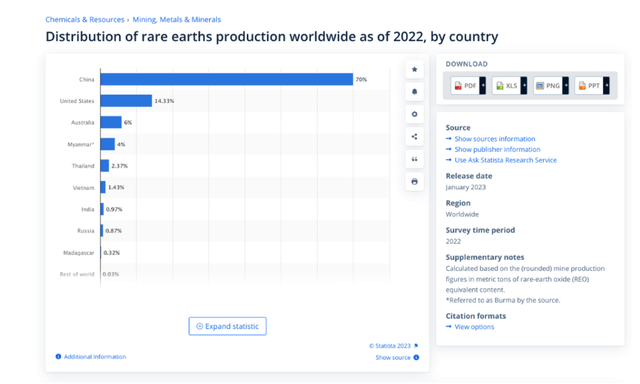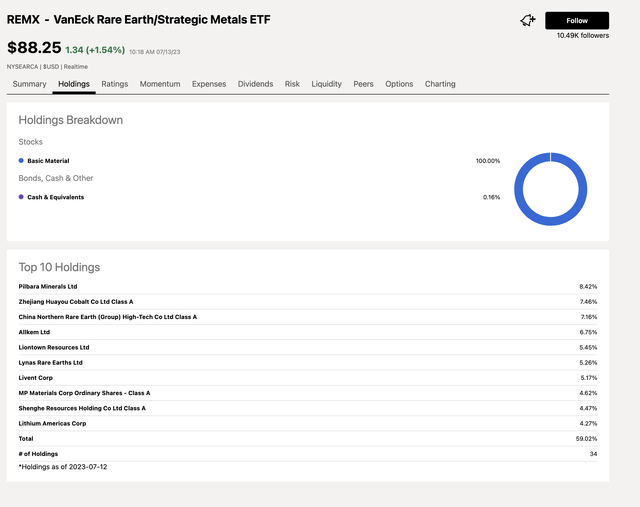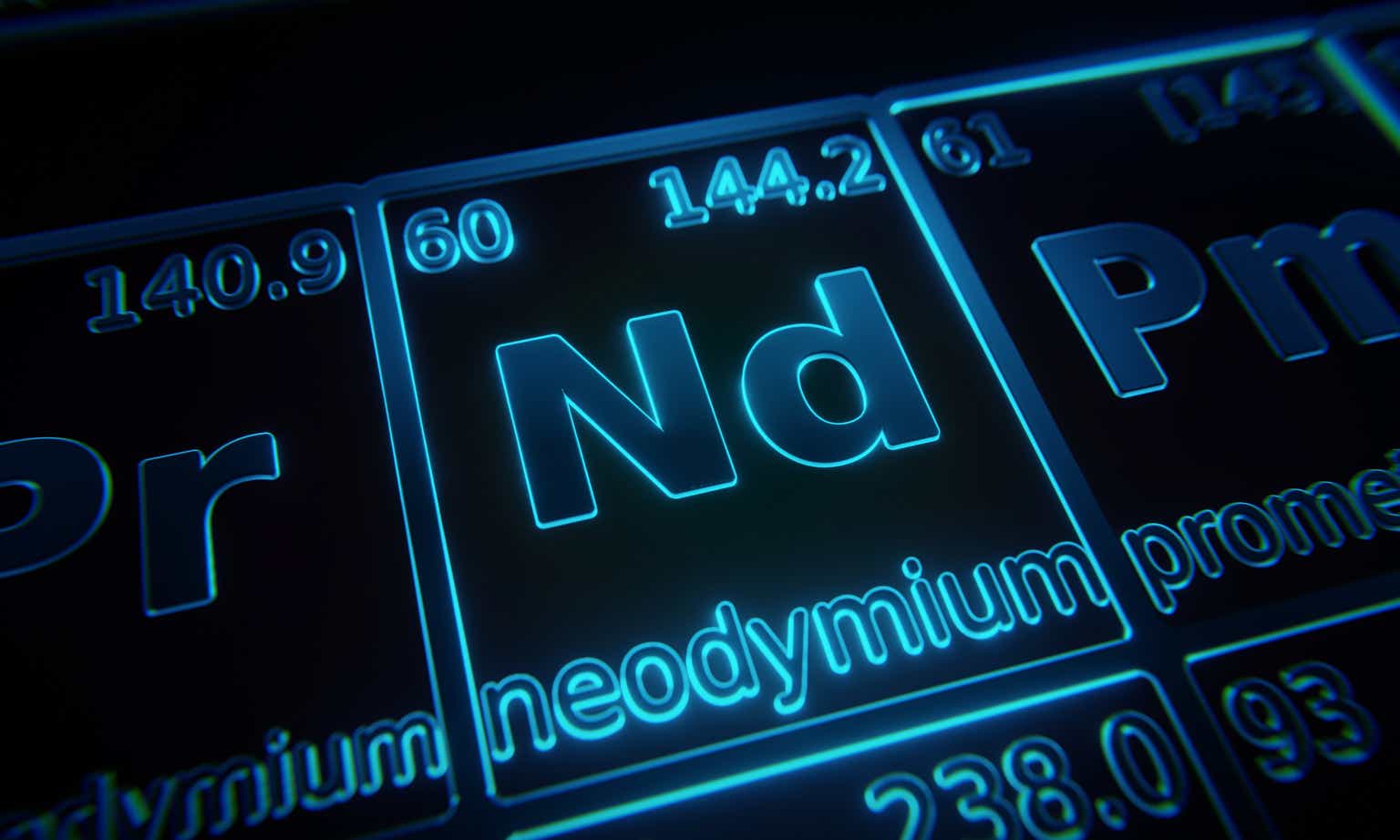In a September 2022 Seeking Alpha article, I outlined the three reasons to consider buying the VanEck Rare Earth/Strategic Metals ETF (REMX) and the one factor why investors and traders needed to proceed with caution. The bullish factors for the sectors included increasing demand, China’s supply monopoly, and geopolitics. The warning was, “Rare earth supplies are a geopolitical issue that will continue to cause volatility and boom and bust periods for the metal’s prices.” On September 8, REMX was at the $99.44 per share level. Over the past months, the ETF dropped to a $73.05 low in March 2023. At over $88 per share on July 13, REMX has been edging higher, and recent events in China could support gains in the non-Chinese companies REMX owns.
U.S. relations with China
Last weekend, U.S. Treasury Secretary Janet Yellen traveled to Beijing to seek cooperation in a challenging geopolitical environment. Since February 2022, when Chinese President Xi and Russian President Putin shook hands on a “no limits” alliance, the bifurcation of the world’s nuclear powers created geopolitical tensions with significant global economic ramifications.
Russia’s invasion of Ukraine followed the handshake less than one month later, and Chinese plans for reunification with Taiwan only exacerbated tensions.
Geopolitics and economics are closely connected, and the current division has led to a more towards de-dollarization and the potential for a BRICS currency backed by gold to challenge the U.S. dollar’s reserve currency role and U.S. dominance on the international financial landscape.
Meanwhile, commodities are global assets. International relations can lead to tariffs, export bans and restrictions, and supply chain issues that impede the flow of raw materials from producers to consumers.
China limits germanium and gallium exports
On July 3, less than one week before Treasury Secretary Yellen arrived in Beijing, China restricted germanium and gallium exports for “national security” reasons.
Germanium ores are rare, with most germanium a by-product of zinc output and coal fly ash. China produces around 60% of the world’s germanium. Gallium metal comes from processing bauxite, the primary ingredient in aluminum production. China produces over 80% of the world’s gallium.
Gallium and germanium have high-tech applications. Fiber optic cables, 5G telecommunications masts, military-grade thermal imaging, lasers, light-emitting diodes or LEDs, satellite solar panels, and rare-earth magnets in EV engines require the metals. Germanium and gallium are also semiconductor ingredients. While the U.S. has a germanium strategic stockpile, it has no gallium inventories.
Meanwhile, the recent export restrictions could be China’s first step in limiting the flow of critical metals to the U.S. and its allies.
Rare earths are not typical liquid commodities
China has a dominant role in germanium and gallium supplies, and the same applies to rare earth metals. Rare earths are a collection of seventeen metallic elements, including fifteen lanthanides on the periodic table, plus scandium and yttrium. The rare earths are not typical commodities as they are illiquid, preventing them from trading on futures exchanges. The illiquidity of the physical market leads to extreme price volatility compared to other, more liquid raw material markets.
Advancing technology has increased the demand side of rare earth metals’ fundamental equations.

Rare Earth Metals Production By Country in 2022 (Statista)
The chart highlights China’s 70% market share of the 2022 rare earth metals distribution, nearly five times the supplies from the second-place United States. As the world’s leading economy, the U.S. rare earth metals requirements are rising each year.
Semiconductors are at the center of the stage
A semiconductor is a material with conductivity between conductors (typically metals) and nonconductors or insulators (generally ceramics). Semiconductors can be pure elements, such as silicon or germanium, or compounds, like gallium arsenide or cadmium selenide.
Therefore, China’s recent export restrictions will significantly impact the worldwide semiconductor manufacturing business.

The Leading Publicly Traded Semiconductor Companies Worldwide (Companiesmarketcap.com)
Seven of the top ten semiconductor companies worldwide are in the United States. Nvidia Corporation (NVDA) is the leading producer, but it produces specialized chips. Taiwan Semiconductor (TSM) is second, with an over 11% share of the publicly traded sector. South Korea’s Samsung (OTCPK:SSNLF) is third, with a 7.7% market cap share. Restricting the critical input supplies could devastate the semiconductor industry, impeding technological advances. Moreover, a Chinese takeover of Taiwan could destroy Taiwan Semiconductor’s position as a vital chip supplier.
Meanwhile, the technology challenges will only increase if China follows suit with rare earth metals restrictions. Therefore, the U.S. and Europe must increase rare earth metals production and processing as soon as possible. A U.S. Geological Survey news release, “Going Critical,” explained:
Rare-earth elements (REE) are necessary components of more than 200 products across a wide range of applications, especially high-tech consumer products, such as cellular telephones, computer hard drives, electric and hybrid vehicles, and flat-screen monitors and televisions. Significant defense applications include electronic displays, guidance systems, lasers, and radar and sonar systems. Although the amount of REE used in a product may not be a significant part of that product by weight, value, or volume, the REE can be necessary for the device to function. For example, magnets made of REE often represent only a small fraction of the total weight, but without them, the spindle motors and voice coils of desktops and laptops would not be possible. In 1993, 38 percent of world production of REEs was in China, 33 percent was in the United States, 12 percent was in Australia, and five percent each was in Malaysia and India. Several other countries, including Brazil, Canada, South Africa, Sri Lanka, and Thailand, made up the remainder. However, in 2008, China accounted for more than 90 percent of world production of REEs, and by 2011, China accounted for 97 percent of world production. Beginning in 1990 and beyond, supplies of REEs became an issue as the Government of China began to change the amount of the REEs that it allows to be produced and exported. The Chinese Government also began to limit the number of Chinese and Sino-foreign joint-venture companies that could export REEs from China.
Geopolitical bifurcation and China’s export restrictions for germanium and gallium exports have spotlighted the “Going Critical” notion.
REMX is a rare earth metals ETF product
As the U.S. and other allies scramble to increase rare earth metal production and processing, the non-Chinese companies in the sector stand to benefit. The top holdings of the VanEck Rare Earth/Strategic Metals ETF include:

Top Holdings of the REMX ETF Product (Seeking Alpha)
While the ETF holds shares in some Chinese producers, the largest holding at 8.42% is in Pilbara Minerals Ltd, an Australian lithium producer and processor. REMX also has a 5.26% investment in Lynas Rare Earths Ltd, the Australian rare earth mining and processing company. The ETF invests 5.45% of its assets in Liontown Resources, the Australian company producing and processing battery metals.
REMX is an ETF that could benefit as the demand for rare earth and strategic metals increases as China restricts exports for “national security” reasons.
At $88.25 per share on July 13, REMX had around $632 million in assets under management. REMX trades an average of 70,496 shares daily and charges a 0.54% management fee. The latest $1.19 annual dividend equates to a 1.06% yield, which more than covers the expense ratio for long-term investors.

Chart of the REMX ETF Product (Barchart)
The chart shows REMX reached a $127.50 per share high in April 2022 after falling to a $23.91 pandemic-inspired low in March 2020. At the $88.25 level, REMX is above the midpoint of the trading range since March 2020.
Chinese restrictions on germanium and gallium could be the first step in choking off critical metal and mineral supplies to the United States and its worldwide allies. The pressure to access these crucial commodities will likely lift prices, increase mining activities, and cause a boom in mining and processing projects over the coming months and years. VanEck Rare Earth/Strategic Metals ETF is a fund that can benefit from the world’s increasing appetite for rare earth and strategic metals and minerals.
Read the full article here













